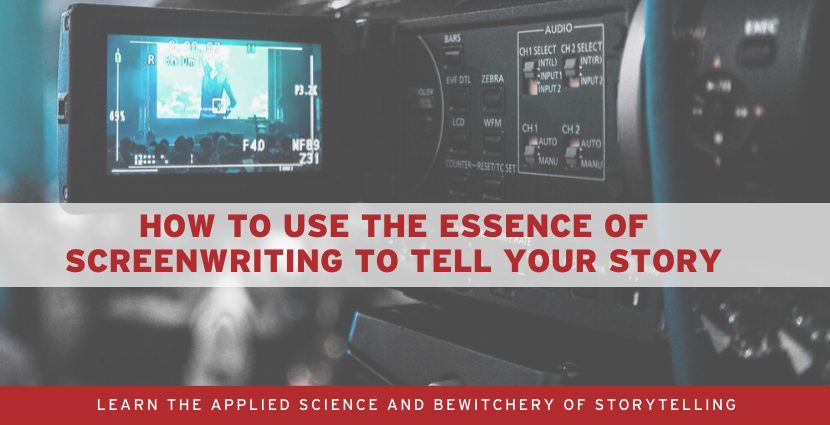Screenwriting follows the rules of storytelling: set up an idea, debate the idea and make a conclusion. Beginning, middle and end. Relatively universal.
But screenwriting also specifically follows rules unique to the medium. These tricks of the trade can be helpful in application to all kinds of business storytelling and content marketing strategies.
Let’s look at some of the key elements of a screenplay and how you can apply to that to creating and telling stories for your brand.
Characters
At the very core of any good screenplay is a compelling protagonist. This is the person leading your story. And any kind of story needs a character guiding you through it.
This character needs to be identifiable and empathetic. Are we on the protagonist’s side instinctively? What is it that makes us on their side? The protagonist needs to have a goal driving them through the narrative. What are they seeking to achieve? Where do they start off and where do they end up?
(Hint: as a brand, you are not the center of your story. Your customers are.)
Where is the character at the beginning and where are they at end? How did they make this journey and what happened during it?
Answer that question and you’ve answered what your content is about and what its aim is. Moreover, you’ve likely answered how successful it is. If you can’t work out the answers to these questions it’s probable you’ll need to go back and clarify how efficient and clear your story is in its purpose and defining goals.
Dialogue
The key to writing convincing dialogue is balancing getting across what the audience needs to know and setting it as realistic within the story.
We can all recognize dialogue that sticks out. This will often be either dialogue that doesn’t feel representative of how people actually talk. Or it will be dialogue that feels too obvious in what it is trying to convey (expositional).
This applies to any kind of content as much as it does a film or TV screenplay. Does the dialogue feel realistic to the scene we are seeing? Is it disguised enough in realistic conversation?
Too much of an easy set up and answer in dialogue will likely only undermine the effectiveness of whatever you are trying to get across.
Furthermore, your dialogue should be as efficient as any other element in your content. Every piece of dialogue, from a long sentence to a mere ‘okay’ should have a purpose. Otherwise what is the point of including it?
What is the motivation and meaning behind each line of dialogue? What is the character getting across? What are you getting across?
It might seem hard to extrapolate deep meaning out of a simple ‘yeah’. But in a story every tiny bit of space matters. Every inclusion is a choice and it’s a choice that should be rooted to your core motivation and purpose for telling your story.
Scene Structure
Similarly to dialogue, every little bit of space in terms of your story’s scenes is precious. You will need to structure your content to get across what you want to as efficiently as possible. But you will also need to mirror this structure in every scene or scenario.
Why is this scene important for your overall message? If your overall story is a puzzle, how do the pieces stack up?
The entry point and exit point of a scene is of vital importance. You need to come in late and leave early. You need to create the idea that this is a scene that is naturally happening and that we are just coming across it.
We are entering and leaving at the places important for us to get what we need from the story. Otherwise what is the point of seeing this scene? What is the point in starting at a point that is unnecessary or leaving at a point that feels extra?
Scenes need to have a rhythm otherwise they have no point. You are taking the audience on a journey in each scene, starting them somewhere and taking them somewhere else.
What is the Imagery Driving Your Story?
What is the imagery at the heart of your content? How does that imagery represent what you are trying to get across?
In writing, conveying what your story looks like is of vital importance. Not only is it obviously what we see visually, but it has the power to encapsulate the story and its themes.
Is there an image that sums up your story? Is there image you can leave your audience with? One that will be much more memorable than a line of dialogue.
This is obviously easier said than done. It’s hard to come up with the perfect piece of imagery to encapsulate your story. But think about what you thought of when you first thought of your story. What were the images that sprung into your mind? What are the images that came before words?
Some think more visually than others. But we all have an image in our mind that we are trying to translate to other people. Try to reach for that image in coming up with the imagery that will make up your story or stand out from it.
How do screenplays relate to storytelling?
Screenplays have a story structure similar to that used in any medium of storytelling. They are principles worth following for all content marketing. Think about how characters, dialogue and images within your content are all working together and independently to get across your story and themes. That’s what any effective and successful story does.
About the Author: James Robert is content writer for Industrial Scripts. Founded in 2010 by a former Warner Bros. and Paramount Pictures script consultant, today Industrial Scripts is one of the world’s leading script development companies. With over 1,000 verified testimonials, we deliver superior support to writers and filmmakers from around the world, while our online and offline training courses educate and inspire. Our popular blog – Character-Driven – informs and entertains.










